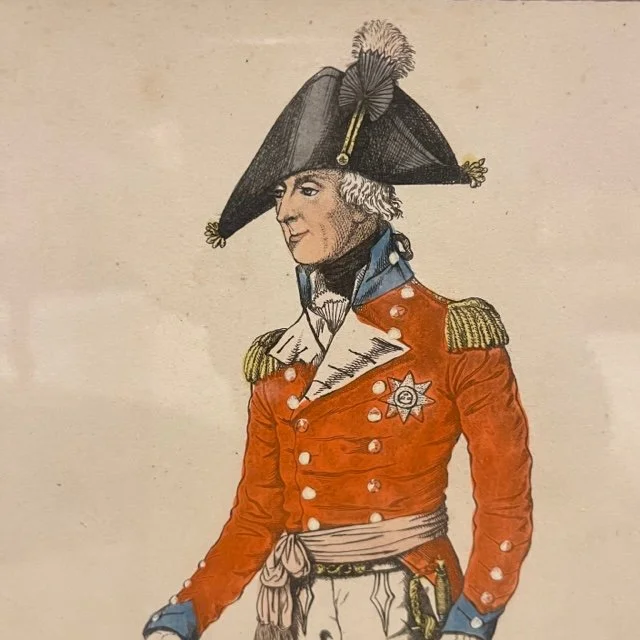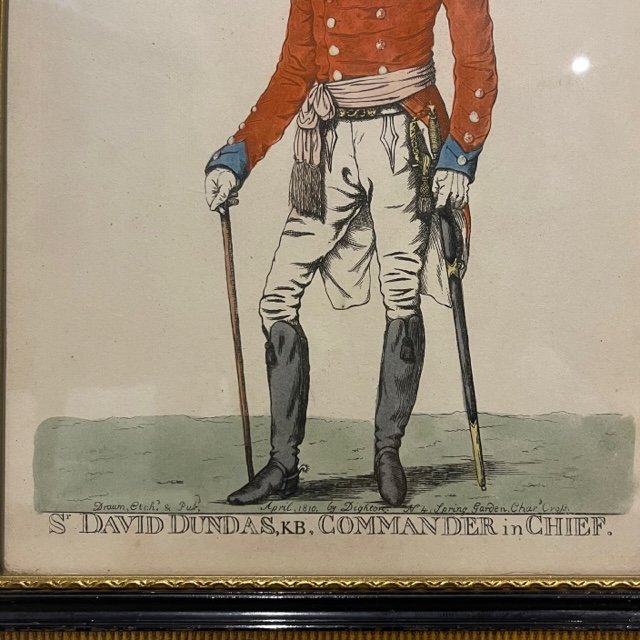 Image 1 of 6
Image 1 of 6

 Image 2 of 6
Image 2 of 6

 Image 3 of 6
Image 3 of 6

 Image 4 of 6
Image 4 of 6

 Image 5 of 6
Image 5 of 6

 Image 6 of 6
Image 6 of 6







Sir David Dundas Commander in Chief Framed Wall Print
Sir David Dundas Commander in Chief
Coloured etching by and after Robert Dighton Snr, published by Robert Dighton Snr, London, April 1810.
A veteran of the German campaigns of the Seven Years War (1756-1763), who did not serve in America, he published the book that made his reputation, 'The Principles of Military Movements', in 1788. Following a succession of staff and field-command appointments he became Commander-in-Chief in March 1809 in succession to the Duke of York, then under a cloud on account of the Mary Anne Clarke scandal. He willingly resigned the post of Commander-in-Chief to York in May 1811.
Print making and print selling ran in the Dighton family. Robert Dighton, Sr. (c.1752-1814) is perhaps the best known of the family. His father, John, was a print seller and Robert, Sr. exercised his artistic talents in acting and singing as well as print-making, selling prints based on his watercolor caricature portraits of actors, actresses, lawyers, military men, and others from his shop in London. His sons Robert, Denis, and Richard worked with him at points and produced their own portraits. He also sold prints made by others and, at least once, owned by others- the British Museum in particular. As a result, he laid low in Oxford from about 1806 to 1810, where he produced portraits of academics and country gentlemen, before returning to London to reopen the shop. Artistic talent extended to his grandsons as well, two of whom also worked in photography.
Size:- 33cm height x 26cm width
£150.00 postage included.
Sir David Dundas Commander in Chief
Coloured etching by and after Robert Dighton Snr, published by Robert Dighton Snr, London, April 1810.
A veteran of the German campaigns of the Seven Years War (1756-1763), who did not serve in America, he published the book that made his reputation, 'The Principles of Military Movements', in 1788. Following a succession of staff and field-command appointments he became Commander-in-Chief in March 1809 in succession to the Duke of York, then under a cloud on account of the Mary Anne Clarke scandal. He willingly resigned the post of Commander-in-Chief to York in May 1811.
Print making and print selling ran in the Dighton family. Robert Dighton, Sr. (c.1752-1814) is perhaps the best known of the family. His father, John, was a print seller and Robert, Sr. exercised his artistic talents in acting and singing as well as print-making, selling prints based on his watercolor caricature portraits of actors, actresses, lawyers, military men, and others from his shop in London. His sons Robert, Denis, and Richard worked with him at points and produced their own portraits. He also sold prints made by others and, at least once, owned by others- the British Museum in particular. As a result, he laid low in Oxford from about 1806 to 1810, where he produced portraits of academics and country gentlemen, before returning to London to reopen the shop. Artistic talent extended to his grandsons as well, two of whom also worked in photography.
Size:- 33cm height x 26cm width
£150.00 postage included.
Sir David Dundas Commander in Chief
Coloured etching by and after Robert Dighton Snr, published by Robert Dighton Snr, London, April 1810.
A veteran of the German campaigns of the Seven Years War (1756-1763), who did not serve in America, he published the book that made his reputation, 'The Principles of Military Movements', in 1788. Following a succession of staff and field-command appointments he became Commander-in-Chief in March 1809 in succession to the Duke of York, then under a cloud on account of the Mary Anne Clarke scandal. He willingly resigned the post of Commander-in-Chief to York in May 1811.
Print making and print selling ran in the Dighton family. Robert Dighton, Sr. (c.1752-1814) is perhaps the best known of the family. His father, John, was a print seller and Robert, Sr. exercised his artistic talents in acting and singing as well as print-making, selling prints based on his watercolor caricature portraits of actors, actresses, lawyers, military men, and others from his shop in London. His sons Robert, Denis, and Richard worked with him at points and produced their own portraits. He also sold prints made by others and, at least once, owned by others- the British Museum in particular. As a result, he laid low in Oxford from about 1806 to 1810, where he produced portraits of academics and country gentlemen, before returning to London to reopen the shop. Artistic talent extended to his grandsons as well, two of whom also worked in photography.
Size:- 33cm height x 26cm width
£150.00 postage included.
